Where? or what? are the Adirondacks you may ask. Since my friend Luz DID ask, here is a blog about it. Driving 5-6 hours from Manhattan, Boston, or Buffalo towards Montreal you will find a quiet, forested, mountainous area with many lakes and few people. The Adirondack Park (aka ‘ADK’ or ‘the ‘dacks’) in Northern New York (the REAL upstate NY) is a region of about 6 million acres or 9,000 square miles, approximately the size of VT or larger than Yellowstone, Everglades, Glacier, and Grand Canyon National Parks combined. Outlined by the ‘Blue Line’, it extends from the southern tip of Lake George north to Plattsburgh on the Canadian border and from the shoreline of Lake Champlain west to Watertown, NY near Lake Ontario. What makes the Park unique, aside from it’s history and geography, is the combination of public and private land ownership; the roughly 45% publicly owned Forest Preserve has been designated ‘forever wild’ by state constitutional mandate from 1894. As you can imagine, there are many interested parties participating in the ‘tug of war’ on how best to manage the resources and future of the Park: private land owners, environmental groups, local businesses and large corporations, tourists, politicians, state and local governments, and more. The park is managed by the NYS Dept. of Environmental Conservation (DEC) and the Adirondack Park Agency (APA) following a state master plan, in addition to the usual county and town government oversight of the private lands. As a result, the ADK is an ongoing real-time experiment in the struggle for balance between naturally destructive humankind and stewardship of these beautiful lands.

A little history of the ADK:
The Adirondacks were originally settled by the Iroquoian Mohawk and Oneida tribes. The name ‘Adirondack’ possibly refers to ‘eaters of trees’ or ‘barkeater’ since some tribes may have had to eat tree bark to survive the harsh winters. Later, the ADK forest became a lucrative source of lumber especially during Reconstruction following the Civil War. Heavy deforestation led to concerns regarding the deterioration of the watershed and thus the Park’s ‘Forever Wild’ status was instituted late in the 1800’s. Meanwhile, early adventure seekers and wealthy vacationers visited the ADK to recreate and explore, so alongside the local lumber boom towns exclusive rustic resorts and lodges were built. Many wealthy families, like the well known Rockefellers, Vanderbilts, and Durants, among others, built ‘Great Camps’ on the pristine lakes during the Gilded Era (late 1800’s) to provide a summer escape if the Newport, RI scene was too taxing. These architectural yet rustic gems were designed to blend in with the local environment using natural materials and typically had a distinctive look using jerkinhead overhangs, birch bark and twig decoration, and massive stone fireplaces and had separate buildings for different functions: dining hall, library, sitting room, bowling alley, etc. Locals were employed to build and maintain these often self-sufficient compounds and serve the wealthy as caretakers, guides, cooks, and waitstaff if they weren’t already working as lumberjacks. Around this time Saranac Lake became known as a tuberculosis cure center due to the efforts of Dr. E. L. Trudeau (a cured TB patient himself) prior to the discovery of streptomycin antibiotic treatment (1944). The clear, cold air was prescribed for TB treatment and a whole industry was built to house and serve TB patients in local homes. These ‘cure cottages’ had second story open porches where TB patients lived 24/7 year round in order to ‘take the cure’. Keep in mind it can get to -30F here in the winter so these patients were bundled up. Sanitariums were built to house many more TB patients and after WWI veterans suffering from mustard gas exposure and susceptible to TB were treated here as well. Vaudevillian actor-patients were housed and supported in the Will Rogers Memorial Hospital, now a retirement village. Some of the more famous TB patients included Robert Louis Stevenson, Christy Mathewson, Manual Quezon, Al Jolson, Maxfield Parrish, and William Morris. Apparently it was a boom time in the whole of Northern NY because also during this time rum-runners and bootleggers were active, smuggling booze across the St. Lawrence from Canada down to NYC during Prohibition.

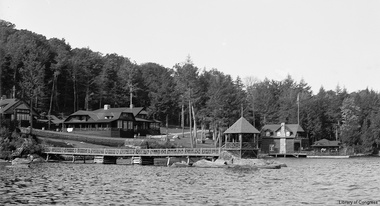
Some famous visitors to this region and other stories: Teddy Roosevelt was hiking here at the time William McKinley was assassinated in Buffalo (1901). Teddy spent about 6 or 7 days after the shooting believing that the 25th President was on the road to recovery and also not wanting to be at the same location as the President with anarchists in the area. Roosevelt was hiking Mt. Marcy, NYS’s tallest peak, on a 21 mile round trip trek when word came that McKinley passed. He sped down the mountain, took a horse and buggy to the nearest train station 35 miles away, and eventually arrived in Buffalo for his immediate inauguration. We actually met the grandson of the man who hiked Marcy TWICE to give news to Roosevelt of McKinley’s condition. This was somewhat of a thrill to Dan who is a huge Teddy Roosevelt fan.
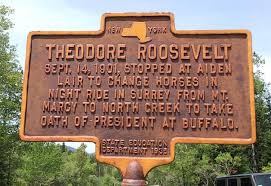
Albert Einstein often summered in the Saranac Lake area and was here on Aug. 6, 1945 when the first atomic bomb was dropped. He also loved to sail despite not knowing how to swim. On one occasion he fell off the boat and was entangled in rigging when a 10 yr old local boy saved him, and also thus, physics.

Faye Dunaway was a waitress in SL (Saranac Lake), Sylvia Plath broke her leg skiing here, Lana Del Ray is from Lake Placid (LP). Garry Trudeau, of Doonesbury fame and a descendent of Dr. Trudeau, grew up in SL. Ok. Enough name dropping.

Geologically speaking, the ADK are ‘new mountains with old rocks’. After a few continental collisions and a weird dome-like uplifting of the area, followed by glacial scarring and sculpting, the ADKs were formed. The dome like lifting continues to this day, thus the mountains actually increase in height about 1 foot every 100 years. The mountains run in an north-northeast direction and rivers tend to run outward from the dome in all directions. Glacier activity left kettle holes and ponds, eskers, cirques, and erratics. And that, my friend, is 1.3 billion years of geologic history in a nutshell.

Of the many mountains within the Park are the ’46 High Peaks’ that rise above 4,000 feet. The exclusive ’46R’ ADK club is limited to those who climb all 46 and register their achievement. Greg completed his 46R challenge in 2018 starting way back some 35 years ago when we first started vacationing here; he finished the last 26 peaks in two years. Now there are many hikers who ‘bag’ the peaks in one year or even, in extreme endurance challenges, in one week! Also remarkable are those who have climbed multiple 46’s, trail run the peaks, or those who climb the 46 in winter; my brother-in-law Serge is one such remarkable athlete, often camping in sub-sub-sub zero temps and snowshoeing or x-country skiing to the peaks. In 2 years. At age 70. Now he relaxes by ice climbing…
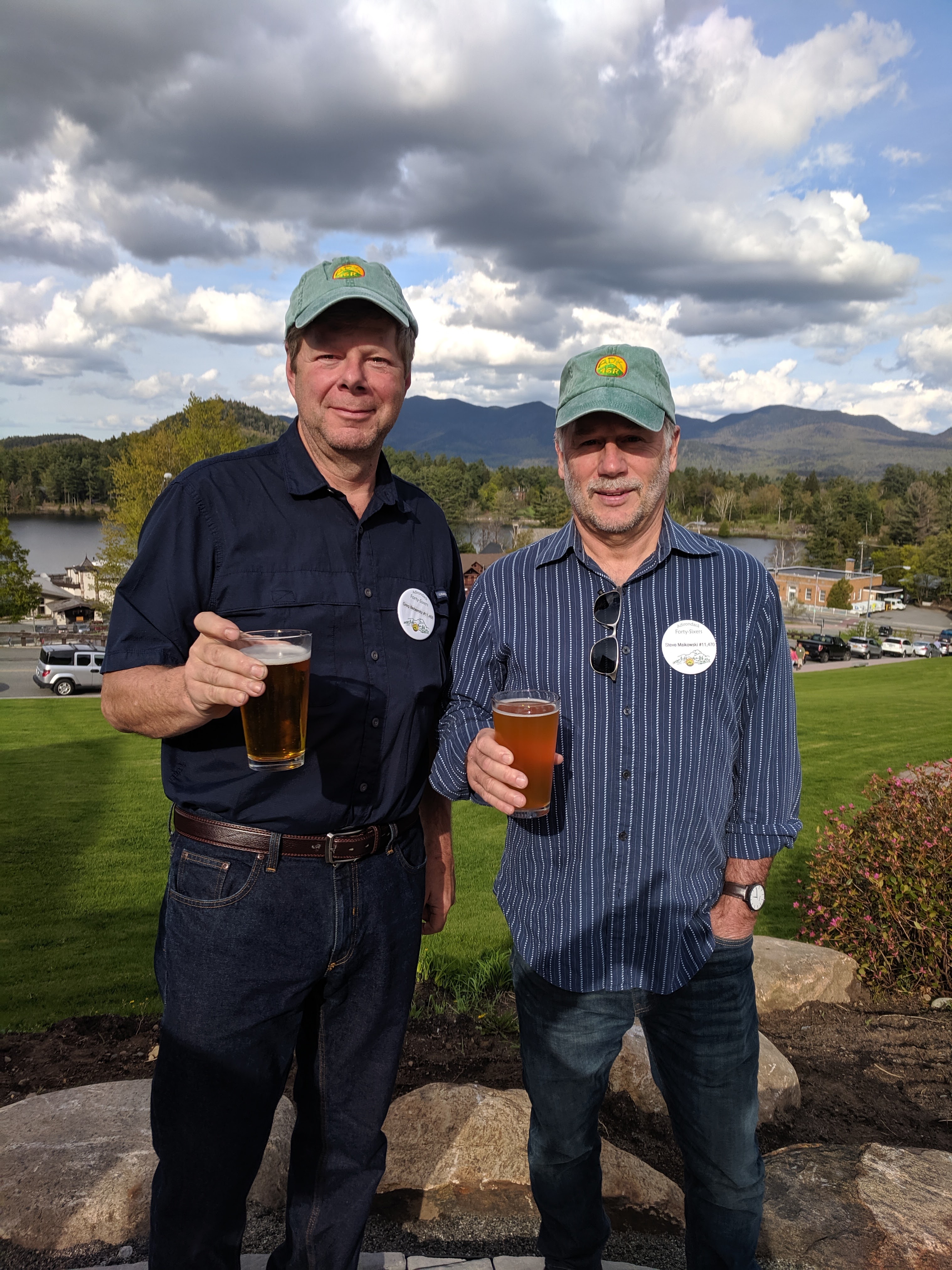

Of the 46 High Peaks, the most accessible are Cascade and Porter mountains with easy access from the trailheads. Of course, these are the most popular and both the trails and the parking can get crowded. Whiteface Mountain is a nice hike (10.1 mi RT) and it’s kinda fun to come up and over to the peak as the tourists who have driven to the top watch in wonder. Mt. Marcy, the tallest in NYS (5344 ft elevation), is a 15 mi RT hike but has a relatively gradual incline.

For those of us somewhat normal humans, there are plenty of moderate peaks that can be done in a 1/2 day or less. My favorites: Mt. St. Regis, a lovely 6.2 mile roundtrip hike to a bald peak with a fire tower. You can see the full extent of our lake from the peak; likewise I see the peak from my house. Hurricane Mountain in the High Peaks area, is not a High Peak but from it’s bald apex (also with firetower) you have an unbelievable view of the higher peaks nearby (7 mi RT). Mt. Van Hoevenberg is a nice little hike near LP that takes only 1.5 hr or less to ascend but the views are expansive with the High Peaks in the distance. Closer to Saranac Lake are Haystack (6.6 mi RT), Baker Mountain (1.7 mi RT), and Scarface (7.4 mi RT); these peaks are not bald but the overlooks have great views for the effort. Ampersand Mt. (5 mi RT) is extremely popular and the view is remarkable from the bald peak; unfortunately overuse has caused the trail to become wide and washed out, but still fun and challenging nevertheless. Saranac Lake offers the ‘Saranac 6’ challenge: climb 6 of the moderate peaks nearby, get a badge and ring the bell in the town center! Tupper Lake offers the ‘Tupper Triad’ challenge: climb Mt. Arab (2 mi RT), Goodman Mtn (3 mi RT), and Coney Mtn (2.2 mi RT) and get a badge. These are nice little family hikes that can be done in one day if you are so motivated (or not). Lake Placid offers the ‘Lake Placid 9’ challenge which I am currently working on. Most any mountain hike in the area will have meandering trails that crisscross rivers and small waterfalls and have changing forest environments.



There are lots of hikes that don’t require significant elevation change; in my area there are Deer Pond Loop, Trombley Landing, and the Raquette River Falls trails. A little more effort but worth the hike is hiking to Avalanche Lake in the High Peaks area. Here you can walk the ‘hitch ’em up Matilda’s’, cliffside boardwalks overhanging Avalanche Lake named after the guides asking adventurous Gilded Era female hikers to hike up their long skirts as they carried them along the shallow waters of the lake’s edge. Yes, hiking in long skirts. There are SO MANY trails to explore and there is also the option to bushwhack to wherever you plan to go (armed with compass and GPS of course!) For those who just want to walk some nice trails in the woods there are plenty. To name a few: Heaven Hill and Henry’s Woods in Lake Placid with great views from the meadows, the Bog River Trail from SL to Bloomingdale, and the Paul Smith’s College Visitor’s Interpretive Center (‘the VIC’) which has miles of trails with views of bogs, mountains, woods, and streams.

Be aware that these hikes seem accessible but there are more than a few instances of hikers getting lost, hurt, or stranded every year. Many assume that NYS (or, generally speaking, northeast US) hiking will be easy and safe. I assure you, these are not all easy hikes and some are very remote without cell signal. We have seen hikers starting late in the afternoon with just sneakers and shorts attempting a long hike. Often we will chat and ask if they know what they are doing since the weather and hiking conditions can be very different from start to finish and injury can make for a long night alone waiting for a rescue from Forest Rangers. Preparation with a compass (and knowledge of how to use it), adequate gear including spare clothes, a flashlight, extra batteries, first aid kit, and plenty of water and/or a filter straw are recommended. Dogs require lots of water too! Cell phones die very fast in cold temps, there is a lack of cell signal in the area, and not all trails are well marked and usually have plenty of loose rocks and tree roots to navigate, not to mention scrambling up or down boulders or slides, that can cause trouble for even the most experienced hikers. Every week we get a NYS DEC report on Forest Ranger rescues and shake our heads at the bad luck or stupidity of some hikers (and we’re grateful we are not in it!) Be safe, people! https://www.dec.ny.gov/press/press.html
I’ve been doing more paddling lately and am investing in a nice light kayak for next year’s adventures. In my immediate area there are lots of lakes and streams worth investigating. Lately we visited Raquette River and the Stony Creek Ponds, Fish Creek from Floodwood Road, Long Pond, Upper St. Regis Lake, and Osgood Pond. And, of course, there were many paddles on our own Upper Saranac Lake. There are lots of places to rent canoes or kayaks for single or multi-day paddles. The second weekend in September there is the ’90 miler’, a 3 day 90 mile canoe/kayak/SUP/rowboat race originating in Old Forge and ending in SL, going right by our dock on the last day. It is rather thrilling to watch and hear the paddlers as they hurry by; some boats carry one person, some up to 8 who paddle in perfect harmony! A nice tradition is the bagpiper who plays while the participants hurriedly portage their boats over Bartlett Carry (my road!) from Upper Saranac to Middle Saranac Lake.

For runners, swimmers, and bikers there is the Lake Placid IronMan in late July, or the Tupper Lake Tinman in early June. BikeADK supports weekend bike tours in the area. There are many 5k, 10k, and half marathon races throughout the year as well. As for camping, just about anywhere (just not above 4000 feet elevation) on state property is available to set up tents; bring a trowel to bury digested waste and a bear canister to NOT feed the bears and be sure you are more than 150ft from streams or trails. There are multiple lean-tos and designated campsites along many of the hiking trails. The NYS DEC has remote camp sites available to reserve, the ADK Loj offers campsites for hikers in the High Peaks area, and Fish Creek Campground is a very popular state campground for families with tents, campers and RV’s. Hire a guide to take you hiking, rock climbing, ice climbing, fly fishing, or paddling if you want to push your limits. In the winter there’s snowshoeing and cross country skiing galore, downhill skiing at Whiteface or the local Mt. Pisgah (Gore and Titus Mountains are not too far away), ice skating on the outdoor Olympic Oval rink or other local rinks, or the various lakes given decent conditions. Mirror Lake has tobogganing and dog sled rides in addition to lake hockey and ice skating. Oh and there’s rock and ice climbing. Why? And how can I forget: there’s lots of good golf around too! http://www.dec.ny.gov/outdoor


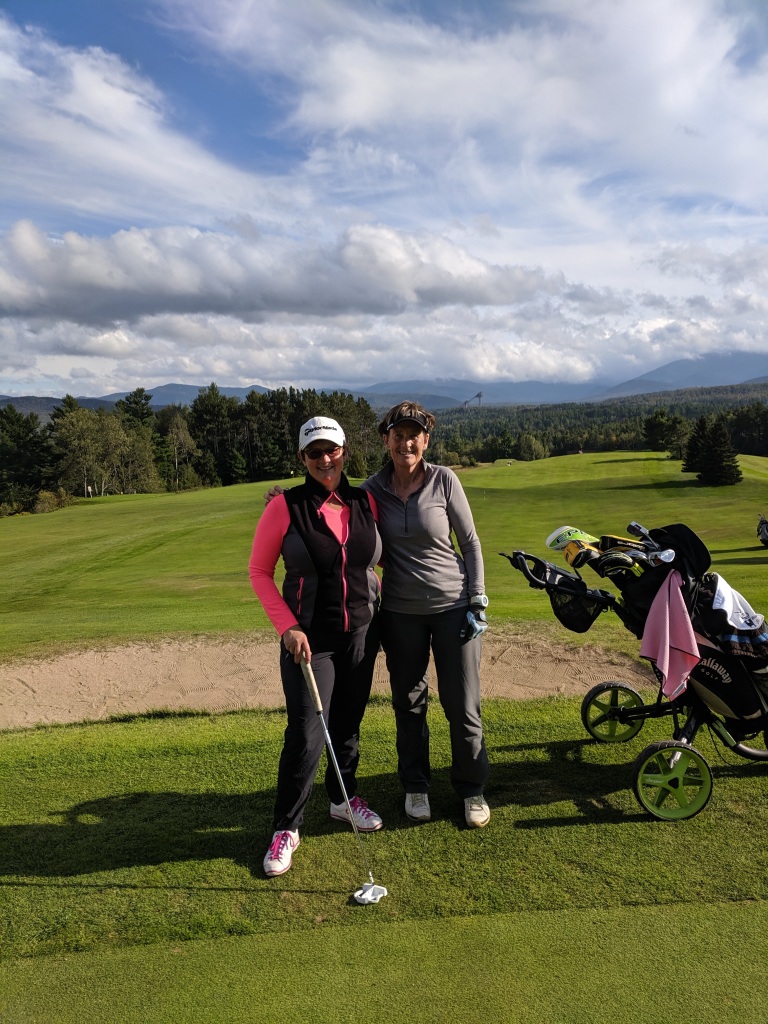
The museums in the ADK are outstanding and are worth visiting if camping, hiking, or paddling aren’t your thing or if it’s a rainy day. My favorite, the Wild Center in nearby Tupper Lake, is an hands-on natural history museum. This beautiful place has outstanding indoor exhibits with live otters, local fish, and birds (raptors, owls, ravens) and various displays describing local ecology, botany, geography, and Haudenosaunee Native American culture. Outdoor exhibits include a giant spider web or eagle’s nest that kids can climb in. There is an elevated walkway to give perspective to tree top biology. One cool exhibit is an actual animal carcass and the various bugs assisting in it’s decomposition. I volunteer as a docent in the Science on a Sphere room, where NOAA programs are projected onto a giant suspended 3D sphere. Animated projections of global real time volcanic activity, ocean currents, earthquake, or weather activity as well as bird, shark, or turtle migration activity connect you with the movements across the globe. Watch as continents shift and collide through the ages, and most frightening: watch the Arctic ice cap melt over time, past and future. https://www.wildcenter.org
Also in Tupper Lake is the Adirondack Sky Center. Currently the observatory is a garage with a retracting roof and several high powered telescopes, run by volunteers in this dark sky region. There is a groundswell effort to build a much larger building and expand their services. The Sky Center is free and open on Fridays with clear nights; their website offers fun astronomy activities. https://www.adirondackskycenter.org/
Another beautiful museum is in Blue Mountain Lake, the Adirondack Experience (aka ADKx), which showcases the history and culture of the ADK. You can watch a boatbuilder hand-build a beautiful guide boat or you can climb on a locomotive or tour a tiny log cabin. https://www.theadkx.org/
Of course, you can tour any of the Olympic sites in and around Lake Placid: skate on the historic Olympic 1980 rink named after the Miracle on Ice coach Herb Brooks, take a bobsled or mountain coaster ride down Mt. Van Hoevenberg, take an elevator or ski lift up to the top of the ridiculously tall ski jumps, or hike, drive, or take a gondola up Whiteface mountain. https://lakeplacidolympicsites.com/
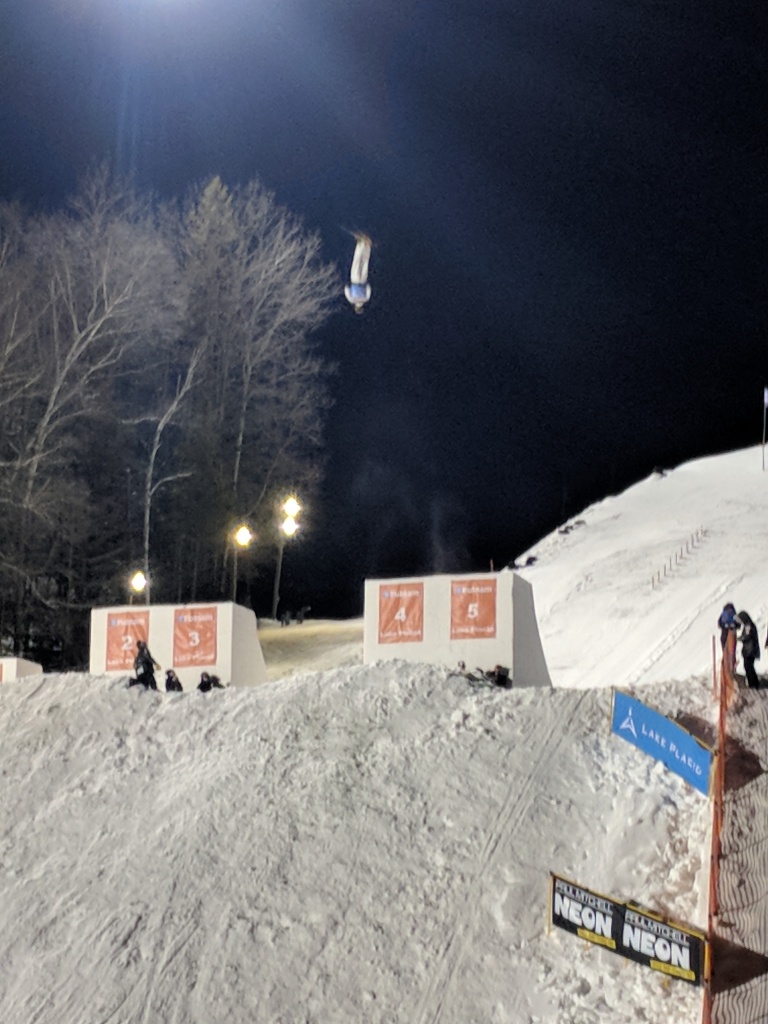
On display at the Saranac Lake History Museum is the laboratory where Dr. Trudeau did his TB research which grew into the Trudeau Institute, a research facility on the shores of Lower Saranac Lake that studies rare viral diseases and TB. In Onchiota is the tiny 6 Nations Museum, and most towns have their own local history museum. There is the John Brown museum in Lake Placid, where the abolitionist lived with his family prior to his assault on the U.S. Arsenal in Harper’s Ferry before the start of the Civil War. He was hanged and is buried on his farm in the ADK within view of the High Peaks. Lots to see and do! https://historicsaranaclake.org/ https://www.sixnationsindianmuseum.com/ https://parks.ny.gov/historic-sites/johnbrownfarm/amenities.aspx
Lake Placid, Saranac Lake, and Tupper Lake are within 20 miles of each other with me basically in the center (it’s my blog and I’ll write if I want to!) Lake Placid (LP) has brand exposure, having hosted 2 Olympic winter games, in 1932 and 1980. This tourist destination has cute shops and eateries and hosts many events: hockey and lacrosse tournaments and a world-class horse show as well as international competitions at the Olympic venues including skating, skiing, bobsled, luge and biathlon. 7 miles west of LP is Saranac Lake (SL), nicknamed ‘the Capitol of the Adirondacks’. It is often the coldest place in the nation located as it is within the mountains. Playing on it’s cold weather fame, SL hosts an annual Winter Carnival in Feb. replete with Ice Palace, fireworks, quirky parades, and a fry pan toss competition. Both SL and LP have vibrant theatre, arts, and music scenes. Tupper Lake (TL), 15 miles further west of SL, is the ‘bluest collar’ village of the three. TL has a long history in the logging industry and is relatively quiet compared to SL and LP. All three have their own personalities and more importantly, great micro-breweries. Or, if ice cream is your thing (it is mine!!!) I’d recommend 2 ice cream places: Emma’s Ice Cream Parlor in LP and Donnelly’s near SL. Donnelly’s serves only 1 softserve flavor each day, but oh, what a creamy confection that swirled delight is!

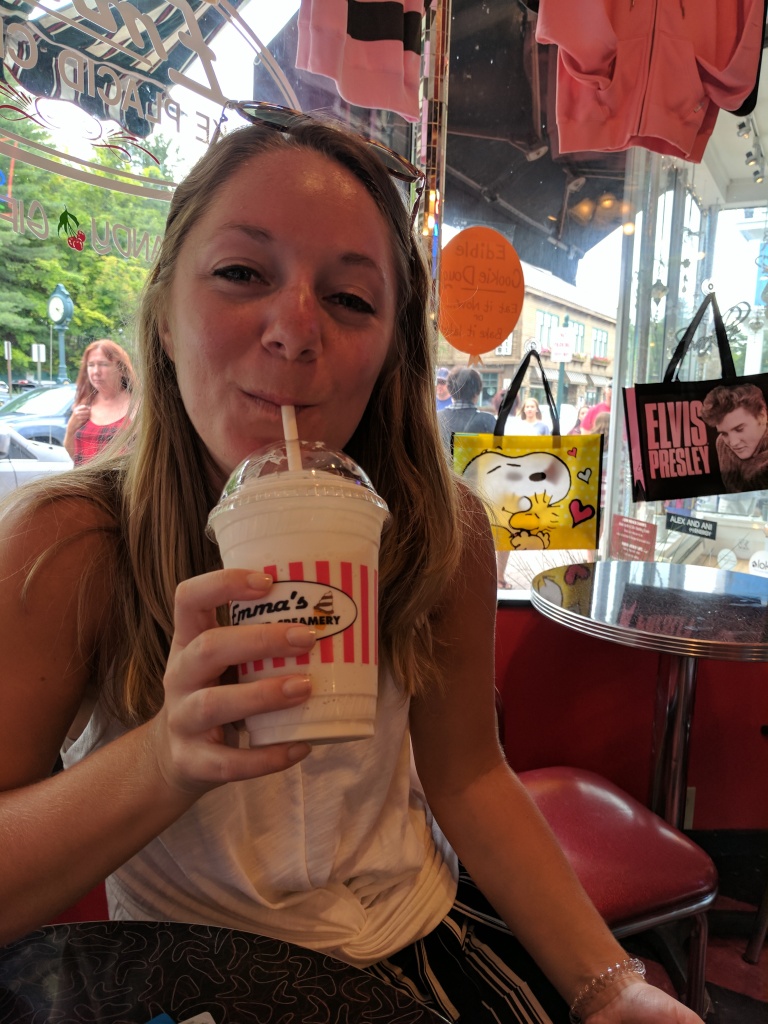
Greg’s Mom was born in the ADK in nearby Piercefield while her dad (Greg’s grandfather) worked in the logging mills and her mom ran a logger’s boarding house. Greg’s mom was principal of the school in Cranberry Lake and his Dad worked on the construction of the 1932 Olympic ski jumps. Greg’s parents met here and are buried here. Although they moved away, they vacationed here for decades and then we did the same until we came to live here. You can say we have roots, tiny but firmly rooted roots, in the area. We love living here. During Coronavirus times, more people visited here than ever. Hiking, camping, and kayaking are naturally social distanced activities. Even without a pandemic, it’s an awesome place. You should visit. And when you do, let me know!
P.S.: As I mentioned at the first, with 9,000 square miles there is a lot of ground to cover. There are many other places to visit and see, from the Lake George region to Old Forge, Indian Lake to Warrensburg to Cranberry Lake, among others.
